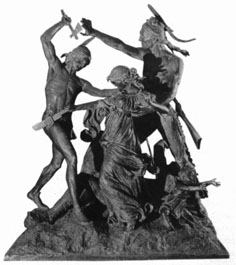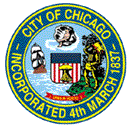|

 |
Monuments to a Lost Nationby Theodore J. Karamanski |
<Reprinted from Chicago History, Spring 2004>
Chicago is an Indian word. Depending on which source you believe, or how you feel about the city, the word means wild onion or stinking place. Men and women of Indian descent were among the founders of Chicago. Chief Billy Caldwell served as a justice of the peace; the city's first sheriff was half Potawatomi. The federal government's removal policy in the 1830s, however, severed the city's Indian roots at a very early date. For the rest of the nineteenth century and much of the twentieth century, Indians were regarded as exotics upon whom the nation's three great stereotypes could be hung: "savage enemy," "noble savage," and "the vanishing American." Indians became a convenient symbol of the primitive and formative pioneer era. They were portrayed as a people locked in the past, a benchmark against which Chicago could measure its progress. The heated public debate over the Chicago icon "Injun Summer" obscured an important area of common ground shared by all Chicagoans. Whereas in the nineteenth century, many people of goodwill, such as the former fur trader Martin Ryerson, pitied the Indians for the loss of their lands, by the twentieth century the majority of Chicagoans responded to the nostalgia of "Injun Summer" because what the Indian had lost earlier was now lost to all residents of the city. Neither the friends nor the foes of "Injun Summer" in the 1990s could regard all that had transpired in their city during their lifetimes as "progress." The baby boom generation witnessed the passing of the last relics of Chicago's rural past. In 1950, more than 20 percent of the land within the city had yet to be built upon. Open lots in the city, where young kids would build "forts" and their parents would burn autumn leaves, were universally referred to as "prairies," in a linguistic linkage between the city and the open Midwestern countryside. Yet during the 1960s, these last open spaces were, one by one, developed for new construction. The very practice of burning leaves, once a seasonal ritual, was found to be a source of air pollution and banned. The last farms in Cook County gave way to subdivisions. Chicagoans were so resistant to giving up these last connections with a lost way of life that in the late 1980s the Chicago Board of Education established a special agricultural high school on the site of one of the area's last farms.
These Indians, largely jammed into the dilapidated Uptown neighborhood, were of less interest to most Chicagoans than the new mythic Indian symbolized by Iron Eyes Cody, the star of the Advertising Council's teary eyed 1971 anti-pollution commercial. Simple recognition of their persistence as a people and their presence in Chicago was and is all the genuine Indians have demanded. The reality of a living Native American community, composed of people who held jobs and raised families like other Chicagoans, conflicted with the symbolic social function of the Indian. Chicago's public memory sometimes depicted the Indian as savage and sometimes as noble, but always the Native Americans were portrayed as part of the landscape and part of the past. In the public art of our parks and print media, the American Indian becomes a figure of nostalgia. Similar to the ghostly dancers in John McCutcheon's cartoon, the image of the Indian reappears to remind of us what was lost in more than a "Century of Progress."
Forward to the credits for this essay Back to the previous page Back to Online Essays |
| |
Department
of Anthropology |
copyright © 2002
University of Illinois, All rights reserved. |

